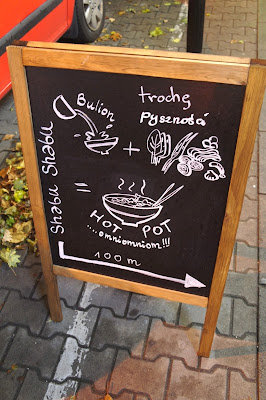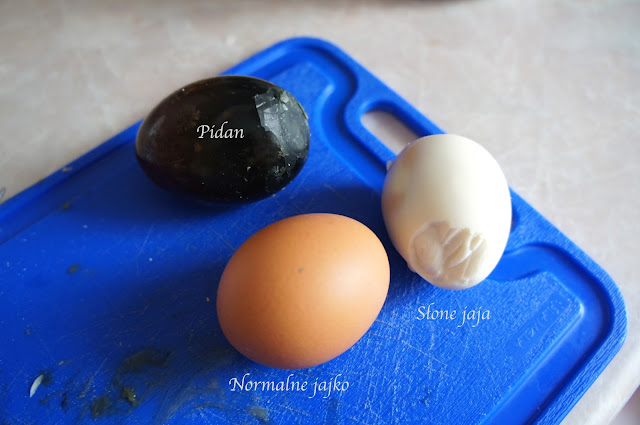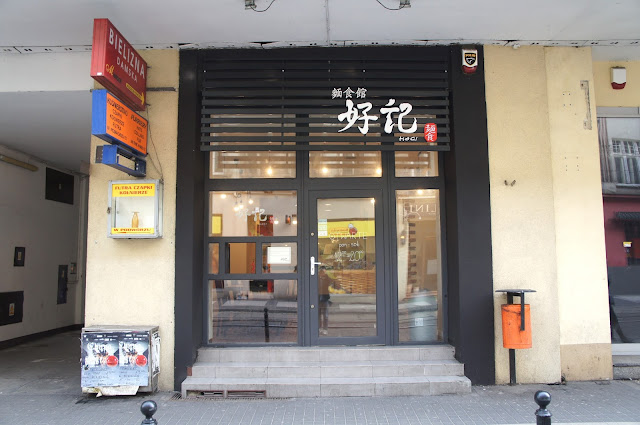Feel like in Asia / Czuć się jak w Azji #18 - Shabu shabu (WAW)
During the winter time, the most popular place you meet in Asia is probablly "huoguo" hotpot restaurants. I miss that time back home, meeting friends in cold winter time for different delicious hotpots with lots of laughter.
However, in Poland I usually make hotpot myself and invite guests but this time I found a place in Warsaw - Shabu shabu.
Actually the name shabu shabu is from Japanese, and it's only a type of hotpot, which was brought back from China to Japan.
Let's take a look of the restaurant itself...
Very familiar basic hotpot equipment setting with tables...
On the wall there are some drawings to show you how to eat hotpot, nice!
Menu!
After checking at the menu I decided just to try the basic set with beef.
Broth...
Here's the set for hotpot!
Doesn't look so much actually...
Time to boil the food!
And then dipping in this prepared sauce. Actually the sauce is something new for me, I think it's Vietnamese style hotpot.
Boiled food is the most healthy!!!
Shabu shabu has many choices and you can also order and add any ingredients they provide separately. After the testing, it's maybe more like Vietnamese hotpot which I have never tasted before so I don't know if it was the right taste. I can only say that it wasn't my taste. Next to shabu shabu is a Vietnamese bar and the owner is the same Vietnamese. If you have never tried hotpot before, it's worth to give it a try to feel how we meet people and eat hotpot in Asia!
For those who like to invite guests and cook at home, welcome for further reading at Duncan's Home Kitchen because when the next hotpot season comes I will try to post a detailed post in Polish how to eat and make hotpot yourself at home!
Shabu Shabu Mokotowska
Mokotowska 27, 00-560 Warszawa
Fb: https://web.facebook.com/ShabuShabuHotPot/?_rdr
During the winter time, the most popular place you meet in Asia is probablly "huoguo" hotpot restaurants. I miss that time back home, meeting friends in cold winter time for different delicious hotpots with lots of laughter.
However, in Poland I usually make hotpot myself and invite guests but this time I found a place in Warsaw - Shabu shabu.
Actually the name shabu shabu is from Japanese, and it's only a type of hotpot, which was brought back from China to Japan.
Let's take a look of the restaurant itself...
Very familiar basic hotpot equipment setting with tables...
On the wall there are some drawings to show you how to eat hotpot, nice!
Menu!
After checking at the menu I decided just to try the basic set with beef.
Broth...
Here's the set for hotpot!
Doesn't look so much actually...
Time to boil the food!
And then dipping in this prepared sauce. Actually the sauce is something new for me, I think it's Vietnamese style hotpot.
Boiled food is the most healthy!!!
Shabu shabu has many choices and you can also order and add any ingredients they provide separately. After the testing, it's maybe more like Vietnamese hotpot which I have never tasted before so I don't know if it was the right taste. I can only say that it wasn't my taste. Next to shabu shabu is a Vietnamese bar and the owner is the same Vietnamese. If you have never tried hotpot before, it's worth to give it a try to feel how we meet people and eat hotpot in Asia!
For those who like to invite guests and cook at home, welcome for further reading at Duncan's Home Kitchen because when the next hotpot season comes I will try to post a detailed post in Polish how to eat and make hotpot yourself at home!
Shabu Shabu Mokotowska
Mokotowska 27, 00-560 Warszawa
Fb: https://web.facebook.com/ShabuShabuHotPot/?_rdr
Słowo "Pi" oznacza "skóra", a "dan" to "jajko". Jaja te nazywają się również "song hua dan", czyli
jaja przypominające kwiat sosny (pine patterned egg).
Oryginalne chińskie nazewnictwo brzmi o wiele lepiej niż wersja polska lub angielska - century egg, to jest stuletnie jaja. Wiem że, "pidan"wyglądają nieładnie, są ciemne bądź prawie czarne. Zagraniczne określenia nie zachęcają raczej do próbowania tych jaj.
Oryginalne chińskie nazewnictwo brzmi o wiele lepiej niż wersja polska lub angielska - century egg, to jest stuletnie jaja. Wiem że, "pidan"wyglądają nieładnie, są ciemne bądź prawie czarne. Zagraniczne określenia nie zachęcają raczej do próbowania tych jaj.
"Pidan" pochodzi z Chin. Według legendy, pewnego dnia kaczka zniosła jaja w popiele (tylenek wapnia). Po 2 miesiącach hodowca kaczek odkrył te jaja i były one twarde i ciemne. Wydarzenie to, to przyczyniło się do odkrycia "pidan".
Do przygotowywania "pidan"
trzeba mieć różne składniki. Jeden z najważniejszych
składników jest zasada (roztwór chemiczny). Poza tym, CaO, liście z herbaty, sól i popiół
rośliny (zależy od przepisu). "Pidan" to tradycyjne danie chińskie, które
można używać do innych potraw, np. popularne "pidan tofu".
Z sklepu azjatyckiego w Poznaniu - Honyu (Święty Marcin 27)
Mocny zapach i smak, ale z czymś się je to nie tak źle!
Najpopularnejsza potrawa
z "pidan" to "pidan tofu". Jest to danie zalewane olejem
sezamowym, sosem sojowym lub octem, posypane szczpiorkeim lub
czosnkiem. "Pidan tofu" jest łatwą potrawą na zimno bez gotowania, podawaną
jako przystawka. Są różne formy "pidan tofu", moją ulubioną jest
ta pochodząca z Tajwanu, którą posypuje się katsuobushi (かつおぶし, suszona
ryba - Bonito). Dodaje ona delikatnego
zapachu i neutralizuje lekko specyficzny smak "pidan".
Jeżli nie zachęciłem cię do spróbowania "pidan", to można spróbować wersji bez "pidan"!
Tu jest filmik krótki o "pidan tofu":
Co dalej?
Zakonserwowane i
przechowywane jaja to nie tylko "pidan", ale także xian dan - SŁONE JAJA,
które jest łatwiejsze do przygotowania. Przepis znajduje się w moim blogu. "Pidan" i "xian dan" są zwykle przygotowane z jajek kaczki, z powodu mocnego
zapachu, twardszej i większej porowatości skorupki.
Trzykolorowe jajko
Nazywa się trzykolorowe, ale jeśli zrobi się je umiejętnie może być wielokolorowe. Tę potrawę przyrządza się z trzech rodzajów jajek: normalnego, słonego i "pidan". W odpowiedniej proporcji gotuje się jajka na parze w pojemniku, a potem kroi. Podajemy je na zimno, czasami z majonezem. Z różnymi kolorami wygląda ciekawie i ładnie. Mieszanie smaków trzech jajek jest w Polsce niespotykane. Jeżeli szukasz potrawy na imprezę lub substytutu na wielkanoc, wybierz trzykolorowe jajko!
Zhou (link) z mięsem i pidan

"Zhou" z mięsem i "pidan", bardzo znany typ zhou, szczególnie w regionie Guandong w Chinach i w Hongkongu. Mięso trzeba chude i trochę marynowane przed ugotowaniem. Pidan zawsze nadaje potrawie specyficzny smak, a jak nie znajdziecie pidan to można dodać jajko.
Feel like in Asia / Czuć się jak w Azji #17 - Oh my pho (WAW)
I was tired of most of the Chinese-Vietmanese or Chinese-Polish bars or restaurants which you can find everywhere in Poland. So I started to search locals in Warsaw and I found some on Fb with good opinions - here comes Oh My Pho!
The place is not super big but in the crowded capital maybe it's just hard to find an ideal one?
Actually seats were pretty soon occupied so you can see how busy they are and the food should be also good..?
Menu, 5% discounts for students!
Pho is actually everywhere and so popular that I just wanted to give it a pass this time. Especially I found something special here, maybe only in Oh My Pho - Bún trộn(mixed with different ingredients): cold noodles with salad, roast pork, nuts, and some herbs.
They also have cards for collecting point...
My friend ordered pho and I also gave it a try, normal taste and good price!
This is my bún trộn, looks awesome!
For a long time I haven't eaten so authentic food, the pork was delicous. Mixed up with some sauce...
Compare the price and the quality, Oh My Pho is definitely a place to visit from time to time, for sure I am gonna come back for other dishes!
Oh My Pho
ul. Wilcza 32, Warsaw
Fb: https://web.facebook.com/ohmyphowilcza/?fref=ts
I was tired of most of the Chinese-Vietmanese or Chinese-Polish bars or restaurants which you can find everywhere in Poland. So I started to search locals in Warsaw and I found some on Fb with good opinions - here comes Oh My Pho!
The place is not super big but in the crowded capital maybe it's just hard to find an ideal one?
Actually seats were pretty soon occupied so you can see how busy they are and the food should be also good..?
Menu, 5% discounts for students!
Pho is actually everywhere and so popular that I just wanted to give it a pass this time. Especially I found something special here, maybe only in Oh My Pho - Bún trộn(mixed with different ingredients): cold noodles with salad, roast pork, nuts, and some herbs.
They also have cards for collecting point...
My friend ordered pho and I also gave it a try, normal taste and good price!
This is my bún trộn, looks awesome!
For a long time I haven't eaten so authentic food, the pork was delicous. Mixed up with some sauce...
Compare the price and the quality, Oh My Pho is definitely a place to visit from time to time, for sure I am gonna come back for other dishes!
Oh My Pho
ul. Wilcza 32, Warsaw
Fb: https://web.facebook.com/ohmyphowilcza/?fref=ts
"Gua bao" - tajwański burger
"Gua bao", czyli jeden z rodzajów "bao", to bardzo popularna potrawa uliczna pochodząca z Chin. Na Tajwanie zwykle zawiera ona 4 główne składniki: ciasto drożdzowe, mięso, kiszone warzywa i przyprawy.
1) Ciasto drożdzowe - "bao" - jest robione podobnie jak pyzy w Polsce. Gdy komuś się spieszy, może użyć pyz.
2) Jeśli chodzi o mięso, ja wolę to z tłustego
boczku wieprzowego, który trzeba długo gotować i marynować w sosie
sojowym aby uzyskać miękką konsystencję. (Można też wrzucić mięso do sosu "luzi" z mojego postu.)
3) W Polsce nie ma
kiszonych warzyw. "Suan cai", czyli warzywa używane na Tajwanie, są tu niedostępne. Podobne warzywa co prawda już pojawiły się w sklepach - nazywają się "bok choy".
Zrobienie ich jest jednak bardzo czasochłonne.
4) Na Tajwanie używamy kombinacji przypraw: kolendra, pieprz, cukier puder i kruszone orzechy ziemne.
"Gua bao" (刈包) jest nazywą tajwańską, w Japonii nazywa się je "kakunimanju" (角煮まんじゅう) i jest to łatwejsza wersja, W Chinach ma ono również inne nazywy i wersje.
Ponieważ "gua bao" jest bardzo pyszne i popularne, nawet w Londynie można
je kupić. Ze względu na wygląd jest również nazywanym "tajwanskim
burgerem".
Przypominam sobie jak po zajęciach na Tajwanie często kupowałem na stoisku takie "gua bao".
Ciepłe "bao" otacza
soczyste mięso i kiszone warzywa, aromatyczne przyprawy i pachnąca kolendra - tradycyjna wersja Tajwańskiego "gua bao" - mniam!





































